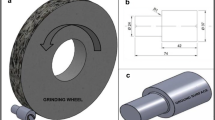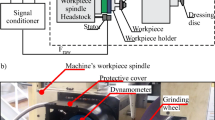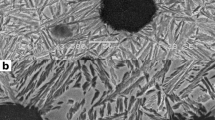Abstract
Residual stresses in machined surfaces are of great importance to the service life of a component under various loading conditions. In many cases, the material damage initiates from the weakest spot with the least compressive stress in the component surfaces. This situation leads to the consideration of residual stress moving beyond the traditional thinking of single or average values to the inclusion of variation of stress values on different measurement points. In this paper, we experimentally investigated the surface and in-depth residual stresses in hardened AISI 1053 steels machined using hard turning and surface grinding processes. Cubic boron nitride (CBN) cutting tools were used in both processes. The effects of depth of cut and number of passes were also studied. It was found that both processes produce a significant amount of compressive stress on the machined surfaces, as well as steep stress gradients underneath the surfaces. Compared with hard turning, surface grinding produces higher magnitudes of average compressive residual stresses, but it also generates up to 14 times higher scattering of residual stresses, indicated by the standard deviation of the residual stress measurements. As a result, the benefits of a highly compressive average residual stress will be offset by highly scattered individual measurements. The stochastic nature of abrasive grit distribution and orientations in grinding wheels is believed to be the contributing factor for the significant scattering. Meanwhile, for hard turning, the variation of surface and in-depth residual stresses greatly increases, up to 3.8 times, with a larger depth of cut and the use of multiple passes; however, this trend is less significant for surface grinding.
Similar content being viewed by others
References
Heindlhofer K (1948) Evaluation of residual stress. McGraw-Hill Book Company, New York
Brinksmeier E, Cammett JT, König W, Leskovar P, Peters J, Tönshoff HK (1982) Residual stresses—measurement and causes in machining processes. Annals of CIRP 31:491–510
Agha S, Liu CR (2000) Experimental study on the performance of superfinish hard turned surfaces in rolling contact. Wear 244:52–59
Liu CR, Mittal S (1998) Optimal prestressing the surface of a component by superfinish hard turning for maximum fatigue life in rolling contact. Wear 219:128–140
Liu CR, Yang X (2001) The scatter of surface residual stresses produced by face-turning and grinding. Mach Sci Technol 5:1–21
Field M, Koster W (1978) Optimizing grinding parameters to combine high productivity with high surface integrity. Ann CIRP 27:523–526
El-Helieby SOA, Rowe GW (1980) A quantitative comparison between residual stresses and fatigue properties of surface-ground bearing steel. Wear 58:155–172
Harris TA, Ragen MA, Spitzer RF (1992) The effect of hoop and material residual stresses in the fatigue life of high speed, rolling bearings. Tribol Trans 35(1):194–198
Liu CR, Mittal S (1995) Single-step superfinishing using hard machining resulting in superior surface integrity. J Manuf Syst 14:129–134
Liu CR, Mittal S (1996) Single-step superfinish hard machining: feasibility and feasible cutting conditions. Robot Comput Integr Manuf 12:15–27
Abrao AM, Aspinwall DK (1996) The surface integrity of turned and ground hardened bearing steel. Wear 196:279–284
Mamalis AG, Kundrak J, Gyani K (2002) On the dry machining of steel surfaces using superhard tools. Int J Adv Manuf Technol 19:157–162
Liu CR, Mittal S (1998) A method of modeling residual stresses in superfinish hard turning. Wear 218:21–33
Saini S, Ahuja IS, Sharma VS (2012) Modelling the effects of cutting parameters on residual stresses in hard turning of AISI H11 tool steel. Int J Adv Manuf Technol. doi:10.1007/s00170-012-4206-0
Grzesik W, Rech J, Wanat T (2006) Surface integrity of hardened steel parts in hybrid machining operations. J Achiev Mater Manuf Eng 18:367–370
Rech J, Moisan A (2003) Surface integrity in finish hard turning of case-hardened steels. Int J Mach Tools Manuf 43:543–550
Tonshoff HK, Hertz F (1987) Influence of the abrasive on fatigue in precision grinding. J Eng Ind 109:203–205
Kohli S, Guo C, Malkin S (1993) Energy partition to the workpiece for grinding with aluminum oxide and CBN abrasive wheels. J Eng Ind 117:160–168
Field M, Kahles JF (1971) Review of surface integrity of machined components. Ann CIRP 20:153–163
Leskovar P, Dimo F, Kovač M (1987) Residual stresses as essential criteria for the evaluation of production processes. Ann CIRP 36:409–412
El-Helieby SOA, Rowe GW (1981) Grinding cracks and microstructural changes in ground steel surfaces. Met Technol 8:58–66
Ju Y, Farris TN, Chandrasekar S (1998) Theoretical analysis of heat partition and temperatures in grinding. Trans ASME J Tribol 120:789–794
Prevey PS, Field M (1975) Variation in surface stress due to metal removal. Ann CIRP 24:497–501
Moulik PN, Yang HTY, Chandrasekar S (2001) Simulation of thermal stresses due to grinding. Int J Mech Sci 43:831–851
Hamdi H, Zahouani H, Bergheau JM (2004) Residual stresses computation in a grinding process. J Mater Process Technol 147:277–285
Mahdi M, Zhang L (1998) VI. Residual stresses and surface hardening by coupled thermo-plasticity and phase transformation, International. Int J Mach Tools Manuf 38:1289–1304
Shi J, Liu CR (2005) On predicting softening effects in hard turned surfaces—Part II Finite element modeling and verification. J Manuf Sci Eng 127:484–491
Shi J, Liu CR (2006) On predicting chip morphology and phase transformation in hard machining. Int J Adv Manuf Technol 27:645–654
Yang X, Liu CR, Granht S (2002) An experimental study on fatigue life variance, residual stress variance, and their correlation of face-turned and ground Ti 6Al-4V samples. J Manuf Sci Eng 124:809–819
König W, Berktold A, Koch KF (1993) Turning versus grinding—a comparison of surface integrity aspects and attainable accuracies. Ann CIRP 42:39–43
Huang Y, Liang S (2005) Modeling of cutting forces under hard turning conditions considering tool wear effect. J Manuf Sci Eng 127:262–270
Noyan IC, Cohen JB (1987) Residual stress measurement by diffraction and interpretation. Springer-Verlag, New York
Lu J (1996) Handbook of measurement of residual stresses. The Fairmont Press, Lilburn
Dahlman P, Gunnberg F, Jacobson M (2004) The influence of rake angle, cutting feed and cutting depth on residual stresses in hard turning. J Mater Process Technol 147:181–184
Ulutan D, Erdem Alaca B, Lazoglu I (2007) Analytical modelling of residual stresses in machining. J Mater Process Technol 183:77–87
Author information
Authors and Affiliations
Corresponding author
Rights and permissions
About this article
Cite this article
Martell, J.J., Liu, C.R. & Shi, J. Experimental investigation on variation of machined residual stresses by turning and grinding of hardened AISI 1053 steel. Int J Adv Manuf Technol 74, 1381–1392 (2014). https://doi.org/10.1007/s00170-014-6089-8
Received:
Accepted:
Published:
Issue Date:
DOI: https://doi.org/10.1007/s00170-014-6089-8




